Thyrotropin-Releasing Hormone (TRH) and Somatostatin (SST), but not Growth Hormone-Releasing Hormone (GHRH) nor Ghrelin (GHRL), Regulate Expression and Release of Immune Growth Hormone (GH) from Chicken Bursal B-Lymphocyte Cultures
Abstract
1. Introduction
2. Results
2.1. Characterization and Viability of BBLs Cultures
2.2. Expression of GHRH, TRH, Ghrelin, SST, GH, and Their Receptors in BBLs
2.3. Co-Localization of GH with GHRH-R, TRH-R, GHS-R1a, and SST-R2 in BBLs
2.4. Effect of TRH, Ghrelin and SST Upon GH mRNA Expression in BBLs
2.5. Effect of TRH and SST Upon GH Content and Release in BBLs Cultures
2.6. Inhibitory Effect of SST Upon TRH-Induced GH Release in BBLs
2.7. Effect of TRH and/or SST Upon Intracellular Ca2+ in BBLs Cultures
2.8. Effect of TRH and SST on CREB Phosphorylation at Ser133
2.9. Effect of TRH and SST upon BAFF mRNA Expression in BBLs Cultures
3. Discussion
4. Material and Methods
4.1. Animals and Tissues
4.2. Hormones and Antibodies
4.3. Primary B- Bursal Lymphocytes (BBLs) Cultures
4.4. Treatments
4.5. Immunohistochemistry and Immunocytochemistry
4.6. RNA Isolation and cDNA Synthesis
4.7. RT-PCR
4.8. Quantitative PCR (qPCR)
4.9. SDS-PAGE/Western Blot of pCREBS133
4.10. GH ELISA
4.11. Quantification of Intracellular Ca2+
4.12. Statistical Analysis
5. Conclusions
Author Contributions
Funding
Acknowledgments
Conflicts of Interest
References
- Lu, M.; Flanagan, J.U.; Langley, R.J.; Hay, M.P.; Perry, J.K. Targeting growth hormone function: Strategies and therapeutic applications. Sig. Transduct. Target Ther. 2019, 4. [Google Scholar] [CrossRef]
- Seoane, L.M.; Tovar, S.; Dieguez, C. Physiology of the hypothalamus pituitary unit. In Hypothalamic-Pituitary Diseases, 1st ed.; Casanueva, F., Ghigo, E., Eds.; Springer International Publishing: Cham, Switzerland, 2018; pp. 1–33. [Google Scholar] [CrossRef]
- Stojilkovic, S.S. Signaling pathways regulating pituitary functions. Mol. Cell. Endocrinol. 2018, 463, 1–3. [Google Scholar] [CrossRef] [PubMed]
- Mayo, K.E.; Godfrey, P.A.; Suhr, S.T.; Kulik, D.J.; Rahal, J.O. Growth hormone-releasing hormone: Synthesis and signaling. Proc. Laurent. Horm. Conf. 1995. [Google Scholar] [CrossRef]
- Harvey, S.; Arámburo, C. Growth hormone: Not just a pituitary endocrine. J. Endocr. Disord. 2017, 4, 2–4. [Google Scholar]
- Harvey, S.; Baudet, M.L. Extrapituitary growth hormone and growth? Gen. Comp. Endocrinol. 2014, 205, 55–61. [Google Scholar] [CrossRef]
- Marsh, J.A.; Johnson, B.E.; Lillehoj, H.S.; Scanes, C.G. Effect of thyroxine and chicken growth hormone on immune function in autoimmune thyroiditis (obese) strain chicks. Proc. Soc. Exp. Biol. Med. 1992, 199, 114–122. [Google Scholar] [CrossRef]
- Villanua, M.A.; Szary, A.; Bartke, A.; Esquifino, A.I. Changes in lymphoid organs of Ames dwarf mice after treatment with growth hormone, prolactin or ectopic pituitary transplants. J. Endocrinol. Investg 1992, 15, 587–595. [Google Scholar] [CrossRef]
- Murphy, W.J.; Durum, S.K.; Longo, D.L. Differential effects of growth hormone and prolactin on murine T cell development and function. J. Exp. Med. 1993, 178, 231–236. [Google Scholar] [CrossRef]
- Yoshida, A.; Ishioka, C.; Kimata, H.; Mikawa, H. Recombinant human growth hormone stimulates B cell immunoglobulin synthesis and proliferation in serum-free medium. Acta Endocrinol. 1992, 126, 524–529. [Google Scholar] [CrossRef]
- Jeay, S.; Sonenshein, G.E.; Postel-Vinay, M.C.; Kelly, P.A.; Baixeras, E. Growth hormone can act as a cytokine controlling survival and proliferation of immune cells: New insights into signaling pathways. Mol. Cell. Endocrinol. 2002, 188. [Google Scholar] [CrossRef]
- Bodart, G.; Farhat, K.; Charlet-Renard, C.; Salvatori, R.; Geenen, V.; Martens, H. The somatotrope growth hormone-releasing hormone/growth hormone/insulin-like growth factor-1 axis in immunoregulation and immunosenescence. Front. Horm. Res. 2017, 48, 147–159. [Google Scholar] [CrossRef] [PubMed]
- Zandvliet, M. Canine lymphoma: A review. Vet. Q. 2016, 36, 76–104. [Google Scholar] [CrossRef] [PubMed]
- Hattori, N.; Kitagawa, K.; Inagaki, C. Human lymphocytes express hGH-N gene transcripts of 22 kDa, 20 kDa and minor forms of GH, but not hGH-V gene. Eur. J. Endocrinol. 1999, 141, 413–418. [Google Scholar] [CrossRef] [PubMed][Green Version]
- Chen, H.T.; Schuler, L.; Schultz, R.D. Growth hormone and Pit-1 expression in bovine fetal lymphoid cells. Domest. Anim. Endocrinol. 1997, 14, 399–407. [Google Scholar] [CrossRef]
- Rohn, W.M.; Weigent, D.A. Cloning and nucleotide sequencing of rat lymphocyte growth hormone cDNA. Neuroimmunomodulation 1995, 2, 108–114. [Google Scholar] [CrossRef] [PubMed]
- Weigent, D.A. Lymphocyte GH-axis hormones in immunity. Cell. Immunol. 2013, 285, 118–132. [Google Scholar] [CrossRef] [PubMed]
- Luna, M.; Barraza, N.; Berumen, L.; Carranza, M.; Pedernera, E.; Harvey, S.; Arámburo, C. Heterogeneity of growth hormone immunoreactivity in lymphoid tissues and changes during ontogeny in domestic fowl. Gen. Comp. Endocrinol. 2005, 144, 28–37. [Google Scholar] [CrossRef]
- Render, C.L.; Hull, K.L.; Harvey, S. Expression of the growth hormone gene in immune tissues. Endocrine 1995, 3, 729–735. [Google Scholar] [CrossRef]
- Nera, K.P.; Kyläniemi, M.K.; Lassila, O. Bursa of Fabricius. ELS 2015. [Google Scholar] [CrossRef]
- Luna, M.; Rodríguez-Méndez, A.J.; Berumen, L.; Carranza, M.; Riesgo-Escovar, J.; Baudet, M.-L.; Harvey, S.; Arámburo, C. Immune growth hormone (GH): Localization of GH and GH mRNA in the bursa of Fabricius. Dev. Comp. Immunol. 2008, 32, 1313–1325. [Google Scholar] [CrossRef]
- Rodríguez-Méndez, A.J.; Luna-Acosta, J.L.; Carranza, M.; Harvey, S.; Arámburo, C.; Luna, M. Growth hormone expression in stromal and non-stromal cells in the bursa of Fabricius during bursal development and involution: Causal relationships? Gen. Comp. Endocrinol. 2010, 167, 297–307. [Google Scholar] [CrossRef] [PubMed]
- Luna, M.; Rodríguez-Méndez, A.J.; Luna-Acosta, J.L.; Carranza, M.; Arámburo, C. Expression and function of chicken bursal growth hormone (GH). Gen. Comp. Endocrinol. 2013, 190, 182–187. [Google Scholar] [CrossRef] [PubMed]
- Luna-Acosta, J.L.; Alba-Betancourt, C.; Martínez-Moreno, C.G.; Ramírez, C.; Carranza, M.; Luna, M.; Arámburo, C. Direct antiapoptotic effects of growth hormone are mediated by PI3K/AKT pathway in the chicken bursa of Fabricius. Gen. Comp. Endocrinol. 2015, 224, 148–159. [Google Scholar] [CrossRef] [PubMed]
- Ferone, D.; Van Hagen, P.M.; Semino, C.; Dalm, V.A.; Barreca, A.; Colao, A.; Lamberts, S.W.; Minuto, F.; Hofland, L.J. Somatostatin receptor distribution and function in immune system. Dig. Liver Dis. 2004, 36, 68–77. [Google Scholar] [CrossRef] [PubMed]
- Kamath, J.; Yarbrough, G.G.; Winokur, A.J.P., Jr. The thyrotropin-releasing hormone (TRH) immune system homeostatic hypothesis. Pharmacol. Ther. 2009, 121, 20–28. [Google Scholar] [CrossRef] [PubMed]
- Tang, W.F.; Wang, Y.G.; Zhu, L.; Wan, M.H.; Chen, G.Y.; Xia, Q.; Huang, X. Effect of somatostatin on immune inflammatory response in patients with severe acute pancreatitis. J. Dig. Dis. 2007, 8, 96–102. [Google Scholar] [CrossRef]
- Schneider, K.; Kothlow, S.; Schneider, P.; Tardivel, A.; Göbel, T.; Kaspers, B.; Staeheli, P. Chicken BAFF-A highly conserved cytokine that mediates B cell survival. Int. Immunol. 2004, 16, 139–148. [Google Scholar] [CrossRef]
- Livak, K.J.; Schmittgen, T.D. Analysis of relative gene expression data using real-time quantitative PCR and the 2−ΔΔCT method. Methods 2001, 25, 402–408. [Google Scholar] [CrossRef]
- Vandesompele, J.; De Preter, K.; Pattyn, F.; Poppe, B.; Van Roy, N.; De Paepe, A.; Speleman, F. Accurate normalization of real-time quantitative RT-PCR data by geometric averaging of multiple internal control genes. Genome Biol. 2002, 7. [Google Scholar] [CrossRef]
- Veiga-Fernandes, H.; Mucida, D. Neuro-immune interactions at barrier surfaces. Cell 2016, 165, 801–811. [Google Scholar] [CrossRef]
- Rohrbasser, L.J.; Alsaffar, H.; Blair, J. The Hypothalamus–Pituitary Axis. In Principles of Endocrinology and Hormone Action; Belfiore, A., LeRoith, D., Eds.; Springer: Cham, Switzerland, 2018; pp. 154–196. [Google Scholar] [CrossRef]
- Arámburo, C.; Alba-Betancourt, C.; Luna, M.; Harvey, S. Expression and function of growth hormone in the nervous system: A brief review. Gen. Comp. Endocrinol. 2014, 203, 35–42. [Google Scholar] [CrossRef] [PubMed]
- Hattori, N. Expression, regulation and biological actions of growth hormone (GH) and ghrelin in the immune system. Growth Horm. IGF Res. 2009, 19, 187–197. [Google Scholar] [CrossRef]
- Ko, K.H.; Lee, I.K.; Kim, G.; Gu, M.J.; Kim, H.Y.; Park, B.C.; Park, T.S.; Han, S.H.; Yun, C.H. Changes in bursal B cells in chicken during embryonic development and early life after hatching. Sci. Rep. 2018, 8. [Google Scholar] [CrossRef] [PubMed]
- Quintanar, J.L.; Guzmán-Soto, I. Hypothalamic neurohormones and immune responses. Front. Integr. Neurosci. 2013, 7. [Google Scholar] [CrossRef] [PubMed]
- Piórkowska, K.; Zukowski, K.; Poltowicz, K.; Nowak, J.; Wojtysiak, D.; Derebecka, N.; Wesoly, J.; Ropka-Molik, K. Transcriptomic changes in broiler chicken hypothalamus during growth and development. Int. J. Genom. 2018, 2018, 6049469. [Google Scholar] [CrossRef] [PubMed]
- Anderson, L.L.; Scanes, C.G. Minireview: Nanobiology and physiology of growth hormone secretion. Exp. Biol. Med. 2015, 237, 126–142. [Google Scholar] [CrossRef]
- De Groef, B.; Geris, K.L.; Manzano, J.; Bernal, J.; Millar, R.P.; Abou-Samra, A.B.; Porter, T.E.; Iwasawa, A.; Kühn, E.R.; Darras, V.M. Involvement of thyrotropin-releasing hormone receptor, somatostatin receptor subtype 2 and corticotropin-releasing hormone receptor type 1 in the control of chicken thyrotropin secretion. Mol. Cell. Endocrinol. 2003, 203, 33–39. [Google Scholar] [CrossRef]
- Richards, M.P.; Poch, S.M.; McMurtry, J.P. Characterization of turkey and chicken ghrelin genes, and regulation of ghrelin and ghrelin receptor mRNA levels in broiler chickens. Gen. Comp. Endocrinol. 2006, 145, 298–310. [Google Scholar] [CrossRef]
- Wang, Y.; Li, J.; Wang, C.Y.; Kwok, A.Y.; Zhang, X.; Leung, F.C. Characterization of the receptors for chicken GHRH and GHRH-related peptides: Identification of a novel receptor for GHRH and the receptor for GHRH-LP (PRP). Domest. Anim. Endocrinol. 2010, 38, 13–31. [Google Scholar] [CrossRef]
- Meng, F.; Huang, G.; Gao, S.; Li, J.; Yan, Z.; Wang, Y. Identification of the receptors for somatostatin (SST) and cortistatin (CST) in chickens and investigation of the roles of cSST28, cSST14, and cCST14 in inhibiting cGHRH1-27NH2-induced growth hormone secretion in cultured chicken pituitary cells. Mol. Cell. Endocrinol. 2014, 384, 83–95. [Google Scholar] [CrossRef]
- Csaba, G. Hormones in the immune system and their possible role. A critical review. Acta Microbiol. Immunol. Hung. 2014, 61, 241–260. [Google Scholar] [CrossRef] [PubMed]
- Saito, Y.; Mekuchi, M.; Kobayashi, N.; Kimura, M.; Aoki, Y.; Masuda, T.; Azuma, T.; Fukami, M.; Iigo, M.; Yanagisawa, T. Molecular cloning, molecular evolution and gene expression of cDNAs encoding thyrotropin-releasing hormone receptor subtypes in a teleost, the sockeye salmon (Oncorhynchus nerka). Gen. Comp. Endocrinol. 2011, 174, 80–88. [Google Scholar] [CrossRef] [PubMed]
- Fukusumi, S.; Ogi, K.; Onda, H.; Hinuma, S. Distribution of thyrotropin-releasing hormone receptor mRNA in rat peripheral tissues. Regul. Pept. 1995, 57, 115–121. [Google Scholar] [CrossRef]
- Raiden, S.; Polack, E.; Nahmod, V.; Labeur, M.; Holsboer, F.; Arzt, E. TRH receptor on immune cells: In vitro and in vivo stimulation of human lymphocyte and rat splenocyte DNA synthesis by TRH. J. Clin. Immunol. 1995, 15, 242–249. [Google Scholar] [CrossRef] [PubMed]
- Frohman, L.A.; Kineman, R.D. Growth hormone-releasing hormone: Discovery, regulation, and actions. In Handbook of Physiology: Hormonal Control of Growth; Kostyo, J., Ed.; Oxford University Press: New York, NY, USA, 1999; pp. 189–221. [Google Scholar]
- Martínez-Moreno, C.G.; López-Marín, L.M.; Carranza, M.; Giterman, D.; Harvey, S.; Arámburo, C.; Luna, M. Growth hormone (GH) and GH-releasing hormone (GHRH): Co-localization and action in the chicken testis. Gen. Comp. Endocrinol. 2014, 199, 38–45. [Google Scholar] [CrossRef] [PubMed]
- Martínez-Moreno, C.G.; Giterman, D.; Henderson, D.; Harvey, S. Secretagogue induction of GH release in QNR/D cells: Prevention of cell death. Gen. Comp. Endocrinol. 2014, 203, 274–280. [Google Scholar] [CrossRef] [PubMed]
- Guarcello, V.; Weigent, D.A.; Blalock, J.E. Growth hormone-releasing hormone receptors on thymocytes and splenocytes from rats. Cell. Immunol. 1991, 136, 291–302. [Google Scholar] [CrossRef]
- Weigent, D.A. Expression of lymphocyte-derived growth hormone (GH) and GH-releasing hormone receptors in aging rats. Cell. Immunol. 2013, 282, 71–78. [Google Scholar] [CrossRef][Green Version]
- Chan, K.W.; Yu, K.L.; Rivier, J.; Chow, B.K.C. Identification and characterization of a receptor from goldfish specific for a teleost growth hormone-releasing hormone-like peptide. Neuroendocrinology 1998, 68, 44–56. [Google Scholar] [CrossRef]
- Khandelwal, N.; Breinig, M.; Speck, T.; Michels, T.; Kreutzer, C.; Sorrentino, A.; Sharma, A.K.; Umansky, L.; Conrad, H.; Poschke, I.; et al. A high-throughput RNAi screen for detection of immune-checkpoint molecules that mediate tumor resistance to cytotoxic T lymphocytes. EMBO Mol. Med. 2015, 7, 450–463. [Google Scholar] [CrossRef]
- Wang, C.Y.; Wang, Y.; Li, J.; Leung, F.C. Expression profiles of growth hormone-releasing hormone and growth hormone-releasing hormone receptor during chicken embryonic pituitary development. Poult. Sci. 2006, 85, 569–576. [Google Scholar] [CrossRef] [PubMed]
- Gnanapavan, S.; Kola, B.; Bustin, S.A.; Morris, D.G.; McGee, P.; Fairclough, P.; Korbonits, M. The tissue distribution of the mRNA of Ghrelin and subtypes of its receptor, GHS-R, in humans. JCEM 2002, 87, 2988–2991. [Google Scholar] [CrossRef] [PubMed]
- Hattori, N.; Saito, T.; Yagyu, T.; Jiang, B.H.; Kitagawa, K.; Inagaki, C. GH, GH receptor, GH secretagogue receptor, and Ghrelin expression in human T cells, B cells, and neutrophils. J. Clin. Endocrinol. Metab. 2001, 86, 4284–4291. [Google Scholar] [CrossRef] [PubMed]
- Tanaka, M.; Miyazaki, T.; Yamamoto, I.; Nakai, N.; Ohta, Y.; Tsushima, N.; Wakita, M.; Shimada, K. Molecular characterization of chicken growth hormone secretagogue receptor gene. Gen. Comp. Endocrinol. 2003, 134, 198–202. [Google Scholar] [CrossRef]
- Yu, Y.; Zhang, Y.H.; Xu, Z.Y.; Liu, T.Y.; Wang, Q.X.; Ou, C.B.; Ma, J.Y. Effects of IBDV infection on expression of ghrelin and ghrelin-related genes in chicken. Poult. Sci. 2018, 98, 119–127. [Google Scholar] [CrossRef] [PubMed]
- Harvey, S.; Baidwan, J.S. Thyroidal inhibition of growth hormone secretion in fowl: Tri-iodothyronine-induced down-regulation of thyrotrophin-releasing hormone-binding sites on pituitary membranes. J. Mol. Endocrinol. 1990, 4, 127–134. [Google Scholar] [CrossRef] [PubMed]
- Harvey, S. Thyrotrophin-releasing hormone: A growth hormone-releasing factor. J. Endocrinol. 1990, 3, 345–358. [Google Scholar] [CrossRef]
- Pintér, E.; Helyes, Z.; Szolcsányi, J. Inhibitory effect of somatostatin on inflammation and nociception. Pharmacol. Therap. 2006, 112, 440–456. [Google Scholar] [CrossRef]
- Gahete, M.D.; Durán-Prado, M.; Luque, R.M.; Martínez-Fuentes, A.J.; Quintero, A.; Gutiérrez-Pascual, E.; Córdoba-Chacón, J.; Malagón, M.M.; Gracia-Navarro, F.; Castaño, J.P. Understanding the multifactorial control of growth hormone release by somatotropes. Lessons from comparative endocrinology. Trends Comp. Endocrinol. Neurobiol. 2009, 1163, 137–153. [Google Scholar] [CrossRef]
- Bossis, I.; Porter, T.E. Identification of the somatostatin receptor subtypes involved in regulation of growth hormone secretion in chickens. Mol. Cell. Endocrinol. 2001, 182, 203–213. [Google Scholar] [CrossRef]
- Harvey, S.; Scanes, C.G.; Chadwick, A. The effect of thyrotropin-releasing hormone (TRH) and somatostatin (GHRIH) on growth hormone and prolactin secretion in vitro and in vivo in the domestic fowl (Gallus domesticus). Neuroendocrinology 1978, 26, 249–260. [Google Scholar] [CrossRef] [PubMed]
- Hattori, N.; Shimatsu, A.; Sugita, M.; Kumagai, S.; Imura, H. Immunoreactive growth hormone (GH) secretion by human lymphocytes: Augmented release by exogenous GH. Biochem. Biophys. Res. Commun. 1990, 168, 396–401. [Google Scholar] [CrossRef]
- Hattori, N.; Ikekubo, K.; Ishihara, T.; Moridera, K.; Hino, M.; Kurahachi, H. Spontaneous growth hormone (GH) secretion by unstimulated human lymphocytes and the effects of GH-releasing hormone and somatostatin. J. Clin. Endocrinol. Metab. 1994, 79, 1678–1680. [Google Scholar] [CrossRef]
- Ben-Shlomo, A.; Pichurin, O.; Khalafi, R.; Zhou, C.; Chesnokova, V.; Ren, S.-G.; Liu, N.-A.; Melmed, S. Constitutive somatostatin receptor subtype 2 activity attenuates GH synthesis. Endocrinology 2013, 154, 2399–2409. [Google Scholar] [CrossRef] [PubMed]
- Sugihara, H.; Minami, S.; Okada, K.; Kamegai, J.; Hasegawa, O. Somatostatin reduces transcription of the growth hormone gene in rats. Endocrinology 1993, 132, 1225–1229. [Google Scholar] [CrossRef] [PubMed]
- Morishita, M.; Iwasaki, Y.; Onishi, A.; Asai, M.; Mutsuga, N.; Yoshida, M.; Oiso, Y.; Inoue, K.; Murohara, T. The effects of GH-releasing hormone/somatostatin on the 5′-promoter activity of the GH gene in vitro. J. Mol. Endocrinol. 2003, 31, 441–448. [Google Scholar] [CrossRef][Green Version]
- Ben-Shlomo, A.; Melmed, S. Hypothalamic regulation of anterior pituitary function. In The Pituitary, 4th eds.; Ben-Shlomo, A., Ed.; Elsevier: London, UK, 2017; pp. 23–45. [Google Scholar] [CrossRef]
- Xia, T.; Zhang, Q.; Xiao, Y.; Wang, C.; Yu, J.; Liu, H.; Liu, B.; Zhang, Y.; Chen, S.; Liu, Y.; et al. CREB/TRH pathway in the central nervous system regulates energy expenditure in response to deprivation of an essential amino acid. Int. J. Obes. 2015, 39, 105–113. [Google Scholar] [CrossRef]
- Ben-Shlomo, A.; Melmed, S. Pituitary somatostatin receptor signaling. Trends Endocrinol. Metab. 2010, 21, 123–133. [Google Scholar] [CrossRef]
- Heisler, S.; Reisine, T.D.; Hook, V.Y.H.; Axelrod, J. Somatostatin inhibits multireceptor stimulation of cyclic AMP formation and corticotropin secretion in mouse pituitary tumor cells. Proc. Natl. Acad. Sci. USA 1982, 79, 6502–6506. [Google Scholar] [CrossRef]
- Eigler, T.; Ben-Shlomo, A. Somatostatin system: Molecular mechanisms regulating anterior pituitary hormones. J. Mol. Endocrinol. 2014, 53, R1–R19. [Google Scholar] [CrossRef]
- Trebak, M.; Kinet, J.P. Calcium signaling in T cells. Nat. Rev. Immunol. 2019, 19, 154–159. [Google Scholar] [CrossRef] [PubMed]
- Ritchie, A.K. Thyrotropin releasing hormones stimulates calcium activated potassium current in a rat anterior pituitary cell line. J. Physiol. 1987, 385, 611–625. [Google Scholar] [CrossRef]
- Carew, M.A.; Mason, W.T. Control of Ca2+ entry into rat lactotrophs by thyrotropin-releasing hormone. J. Physiol. 1995, 486, 349–360. [Google Scholar] [CrossRef] [PubMed]
- Lorsignol, A.; Taupignon, A.; Horvath, G.; Dufy, B. Intracellular calcium concentration and hormone secretion are controlled differently by TRH in rat neonatal lactotrophs and somatotrophs. J. Endocrinol. 1997, 154, 483–494. [Google Scholar] [CrossRef] [PubMed]
- Cervia, D.; Petrucci, C.; Bluet-Pajot, M.T.; Epelbaum, J.; Bagnoli, P. Inhibitory control of growth hormone secretion by somatostatin in rat pituitary GC cells: sst2 but not sst1 receptors are coupled to inhibition of single-cell intracellular free calcium concentrations. Neuroendocrinology 2001, 76, 99–110. [Google Scholar] [CrossRef] [PubMed]
- Rosskopf, D.; Schurks, M.; Manthey, I.; Joisten, M.; Busch, S.; Siffert, W. Signal transduction of somatostatin in human B lymphoblasts. Physiol. Cell Physiol. 2003, 284, C179–C190. [Google Scholar] [CrossRef] [PubMed][Green Version]
- Chen, L.; Ran, M.J.; Shan, X.X.; Cao, M.; Cao, P.; Yang, X.M.; Zhang, S.Q. BAFF enhances B-cell-mediated immune response and vaccine-protection against a very virulent IBDV in chickens. Vaccine 2009, 27, 1393–1399. [Google Scholar] [CrossRef]
- Mackay, F.; Browning, J.L. BAFF: A fundamental survival factor for B cells. Nat. Rev. Immunol. 2002, 2, 465–475. [Google Scholar] [CrossRef]
- Tennat, J.R. Evaluation of the trypan blue technique for determination of cell viability. Transplantation 1964, 2, 685–694. [Google Scholar] [CrossRef]
- Martínez-Moreno, C.G.; Ávila-Mendoza, W.Y.; Arellanes-Licea, E.C.; Louie, M.; Luna, M.; Arámburo, C.; Harvey, S. Neuroprotection by GH against excitotoxic- induced cell death in the retinal ganglion cells. Gen. Comp. Endocrinol. 2016, 234, 68–80. [Google Scholar] [CrossRef]
- Laemmli, U.K. Cleavage of structural proteins during the assembly of the head of bacteriophage T4. Nature 1970, 227, 680–685. [Google Scholar] [CrossRef] [PubMed]
- Negritto, M.C.; Manthey, G.M. Overview of blotting. Curr. Protoc. 2016, 13, 8.1.1–8.1.22. [Google Scholar] [CrossRef]
- Luna, M.; Huerta, L.; Berumen, L.; Martínez-Coria, H.; Harvey, S.; Arámburo, C. Growth hormone in the male reproductive tract of the chicken: Heterogeneity and changes during ontogeny and maturation. Gen. Comp. Endocrinol. 2004, 137, 37–49. [Google Scholar] [CrossRef] [PubMed]
- Martínez-Coria, H.; López-Rosales, L.J.; Carranza, M.; Berumen, L.; Luna, M.; Arámburo, C. Differential secretion of chicken growth hormone variants after growth hormone-releasing hormone stimulation in vitro. Endocrine 2003, 17, 91–102. [Google Scholar] [CrossRef]
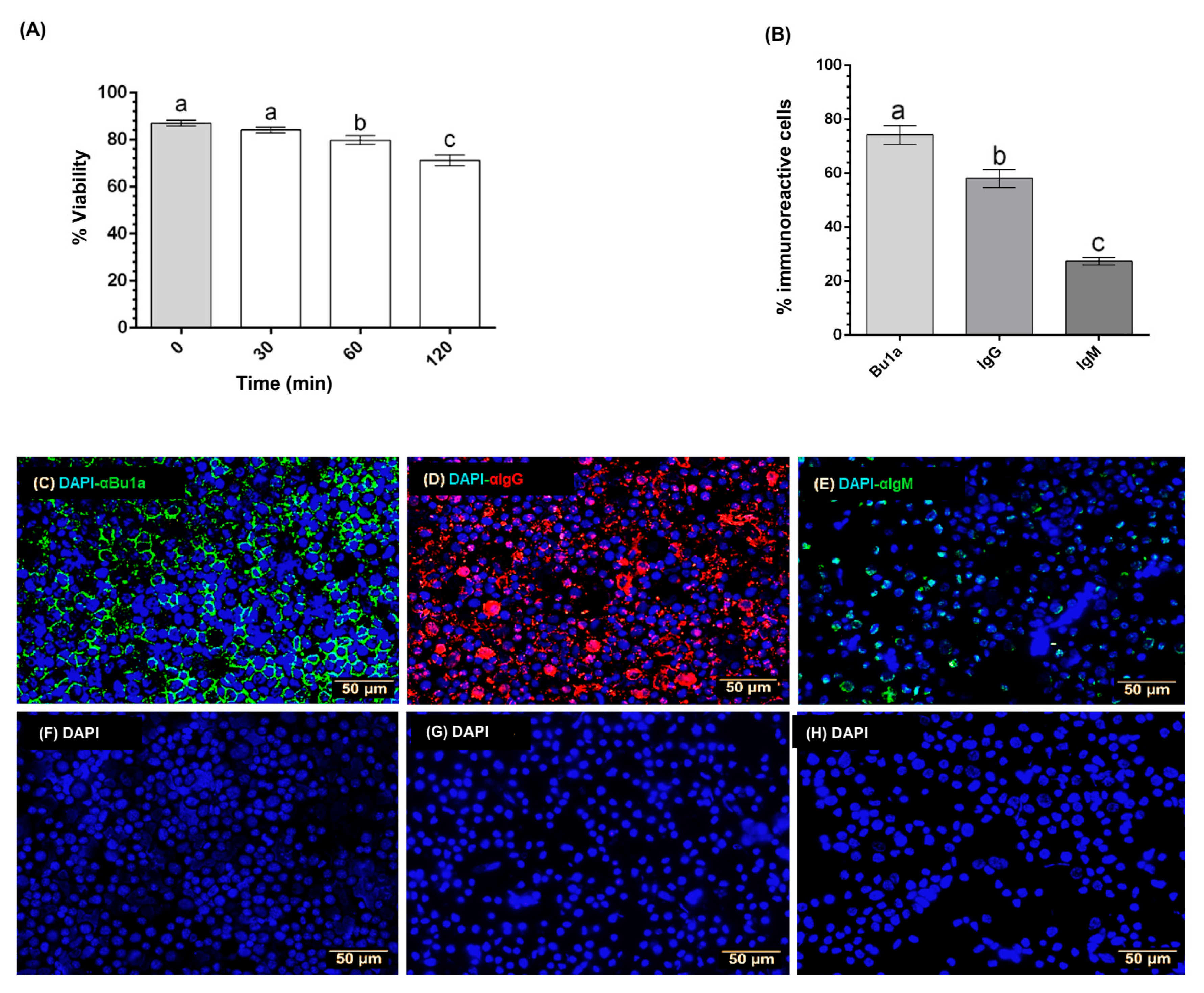
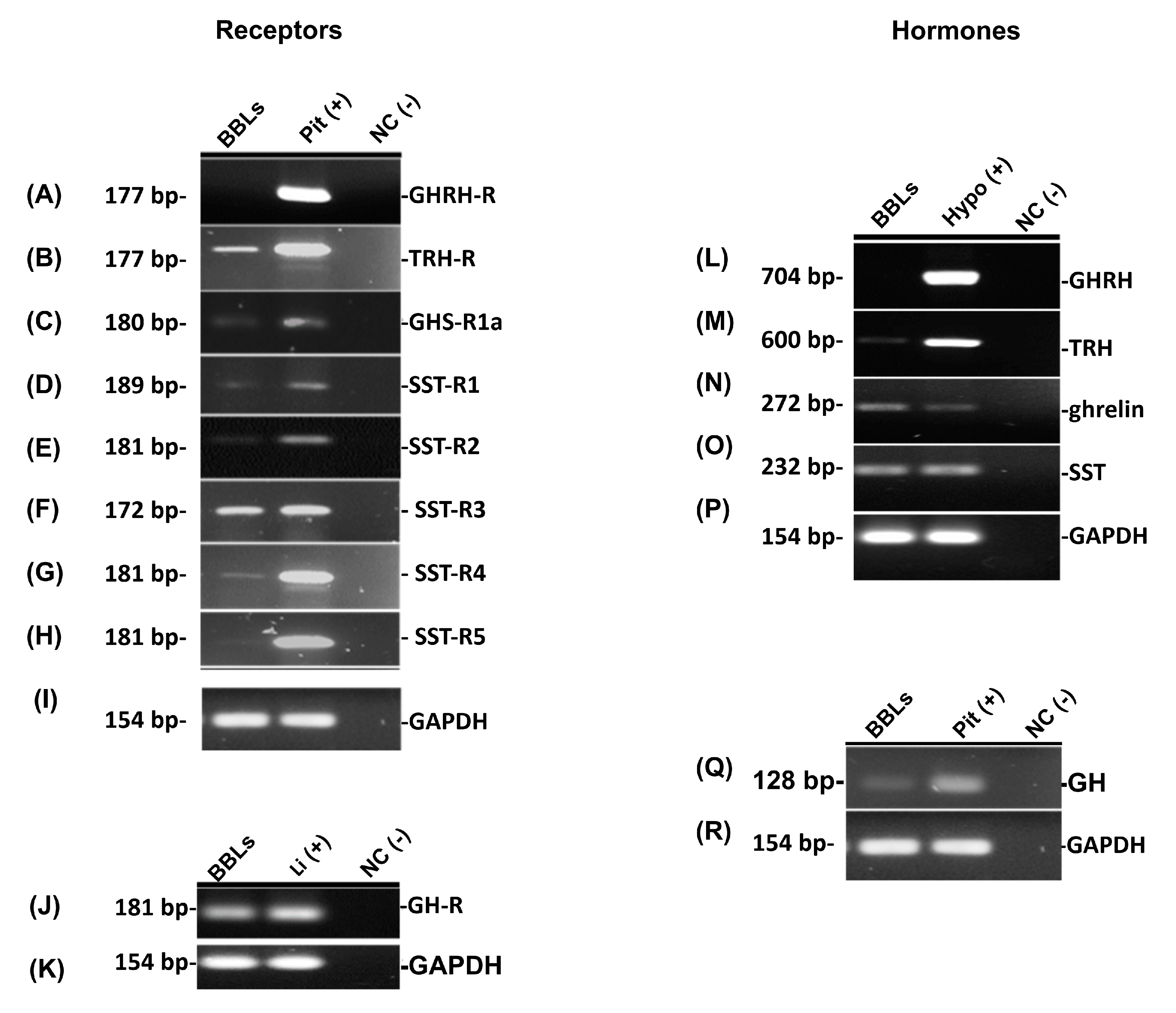
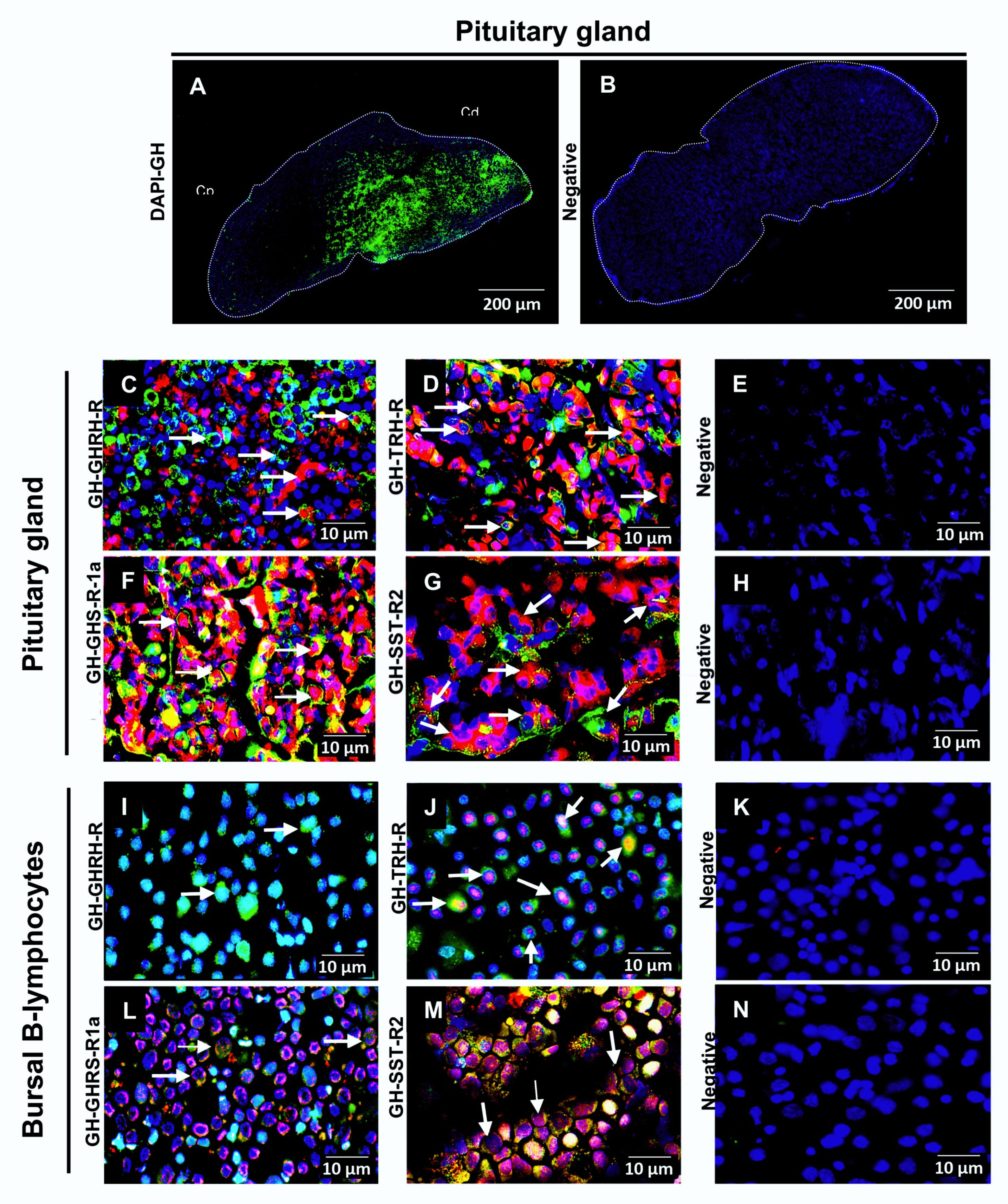
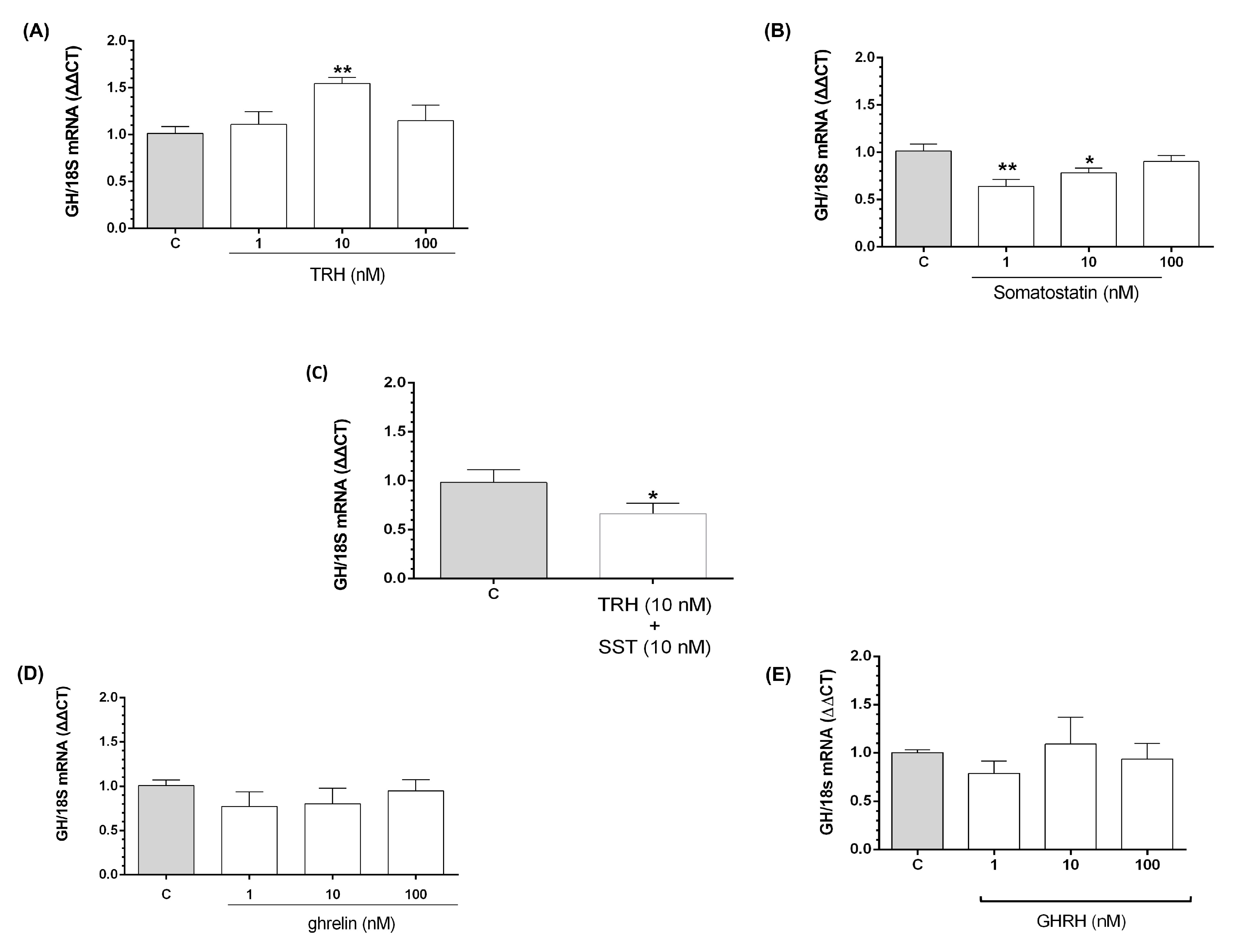
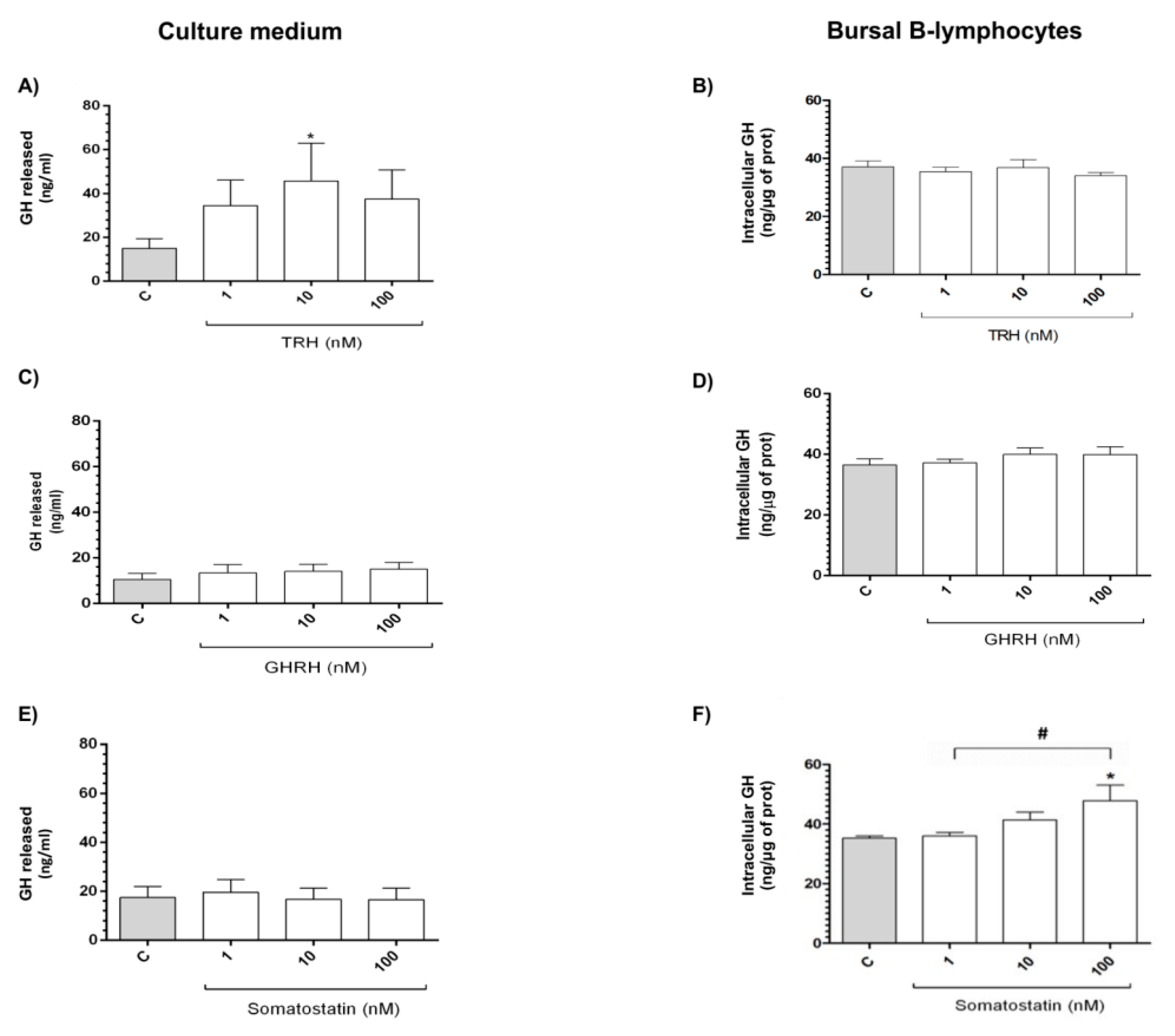
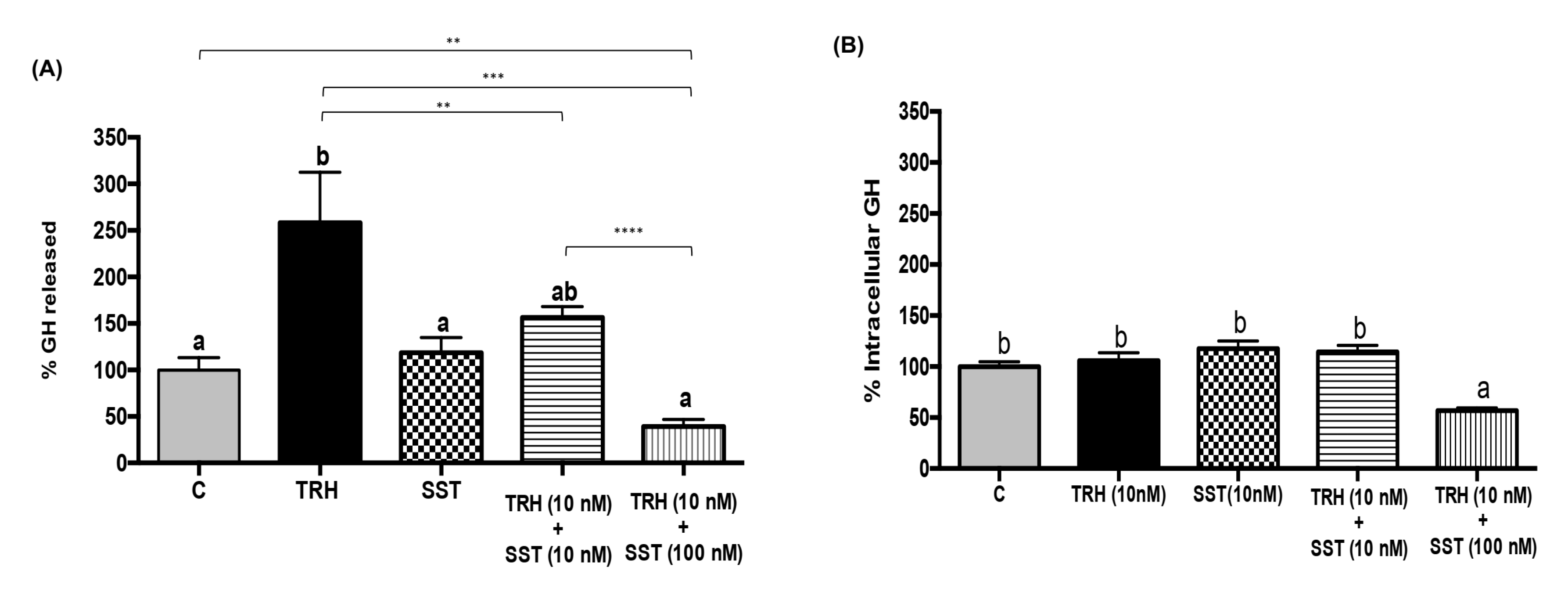
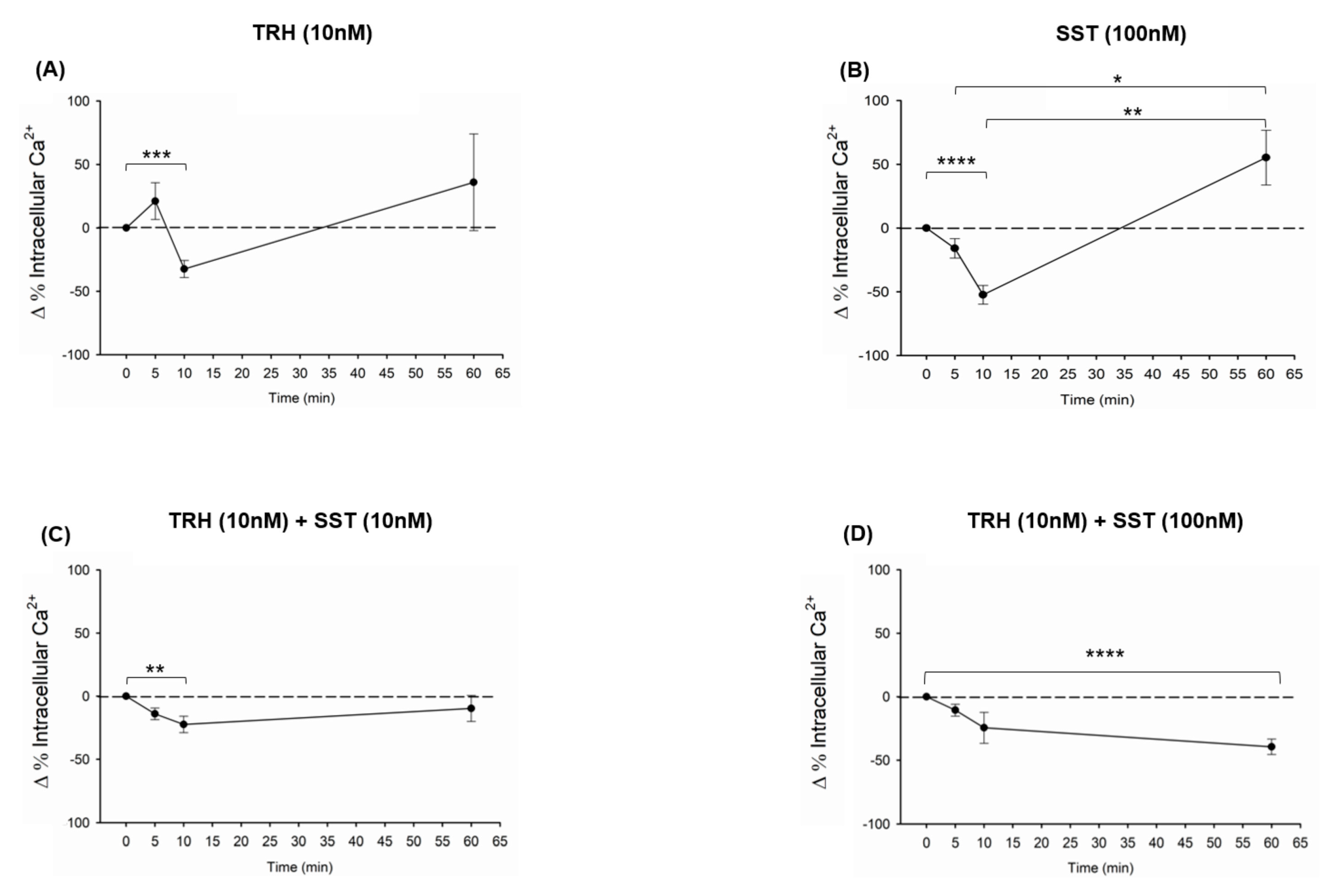
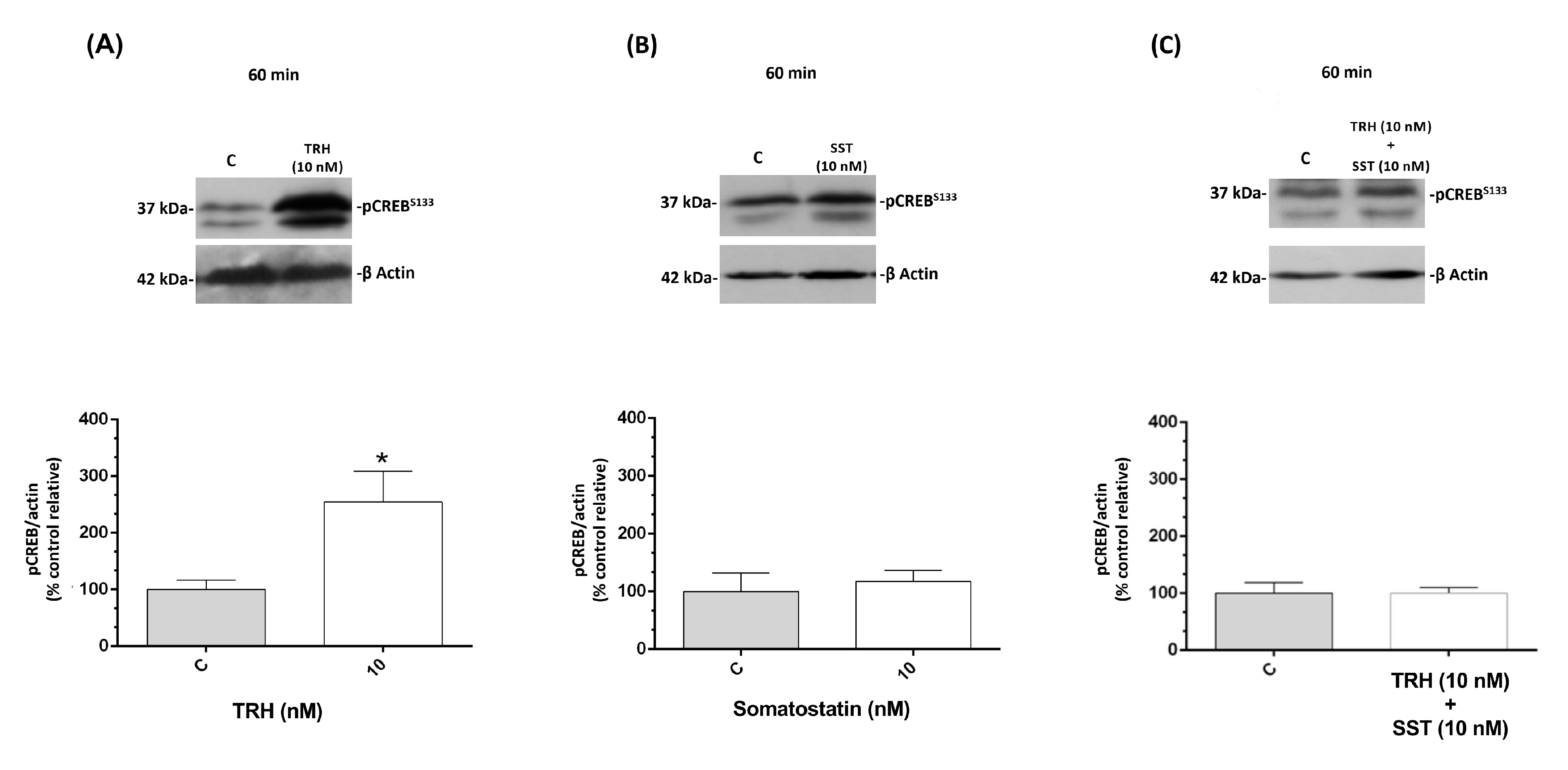
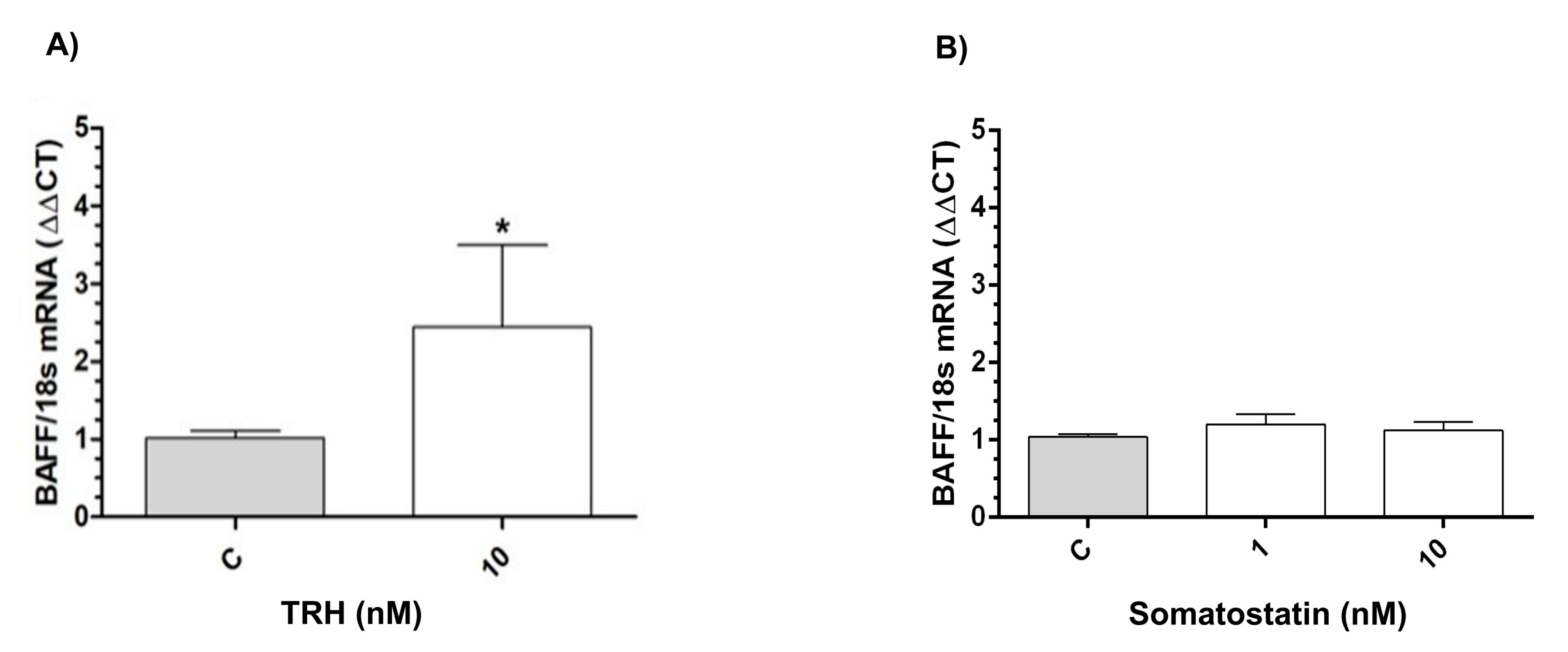
| Target | Host/Type | Dilution | Source | Cat. No. |
|---|---|---|---|---|
| cGH | rabbit/polyclonal | 1:100,000 | NHPP | AFP-551-11-1-86 |
| cGH | guinea pig/polyclonal | 1:2000 | Washington Biotech. | GP-SHA-1 |
| GHRH-R | rabbit/polyclonal | 1:300 | Abcam | ab28692 |
| TRH-R | rabbit/polyclonal | 1:300 | Abcam | ab72179 |
| SST-R2 | rabbit/polyclonal | 1:300 | Sta Cruz Biotechnology | sc-25676 |
| GHS-R1a | rabbit/monoclonal | 1:300 | Sta Cruz Biotechnology | sc-20748 |
| ps133-CREB | Rabbit monoclonal | 1:5000 | Abcam | ab32096 |
| chicken/Turkey IgG | rabbit/polyclonal | 1:100 | Zymed | GI-3100 |
| chicken Bu-1a-FITC | mouse/monoclonal | 1:500 | Southern Biotech | 8365-02 |
| chicken-IgM Antibody-FITC | goat/polyclonal | 1:500 | Rockland | 603-102-007 |
| β-actin | mouse/monoclonal | 1:1000 | Sta Cruz Biotechnology | SC-47778 |
| Alexa Fluor 594 anti-Rabbit-IgG | goat/polyclonal | 1:2000 | Invitrogen | A11012 |
| Alexa 488 anti-Rabbit-IgG | goat/polyclonal | 1:2000 | Invitrogen | A11078 |
| Alexa 488 anti-guinea pig IgG | goat/polyclonal | 1:2000 | Invitrogen | A-11073 |
| Goat anti-Rabbit IgG (H+L) Cross-Adsorbed Secondary Antibody | goat/polyclonal | 1:5000 | ThermoFisher scientific | G-21234 |
| Goat anti-Mouse IgG (H+L) Cross-Adsorbed Secondary Antibody, HRP | goat/polyclonal | 1:5000 | ThermoFisher scientific | G-21040 |
| Target | Primer | Sequence (5′-3′) | Product Size | Accession Number |
|---|---|---|---|---|
| Ligands | ||||
| cGHRH | Fwd | TAC CTG AGT GGG AGC TGA TC | 704 | >NM_001040464.1 |
| Rev | CAT CAG TCT CCA GCT GGT CA | |||
| cTRH | Fwd | ATT AAA CAT GCC TCT GCC ACA | 600 | >XM_025154454.1 |
| Rev | AAA CAA TTA CTT TCT CAT TCC TCT G | |||
| cGhrelin | Fwd | CATACAGCAACAAAAGGATAC | 272 | >NM_001001131.1 |
| Rev | TGTGGTTGTCCTTCAGCT | |||
| cSST | Fwd | CACCTGTCCTCCCCATCCAC | 232 | >NM_205336.1 |
| Rev | CGGAGTGCATGTCACGCAAG | |||
| cGH | Fwd | CGCACCTATATTCCGGAGGAC | 128 | >NM_204359.2 |
| Rev | GGCAGCTCCATGTCTGACT | |||
| cBAFF | Fwd | GATCTCAGCTTGGTGACATTAT | 140 | NM_204327.2 |
| Rev | TTAGCTCTTCTTCGTGGTATTG | |||
| Receptors | ||||
| cGHRH-R | Fwd | GCTGGTCAGAGCCATTCCCTT | 177 | >NM_001037834.2 |
| Rev | AGCGTAGCCTCCTGAATGCCA | |||
| cTRH-R | Fwd | ATGCCCTATCGAACACTGGT | 177 | >NM_204930.1 |
| Rev | ATGGCAGTTGCAGAGTTTCCT | |||
| cGHS-R | Fwd | TGGCCTTCTCCGACCTGCT | 180 | >NM_204394.1 |
| Rev | TGGCGACGTACCGCTCCAC | |||
| cSSTR-1 | Fwd | CCGTGGCTAAGATGGTCAACCT | 189 | >NM_001113167.1 |
| Rev | GCAGCAAGAAGCCCATCAGGA | |||
| cSSTR-2 | Fwd | GGCACCGGTATGTAGGGAGTC | 191 | >XM_015279869.2 |
| Rev | ATGCGTGCTGCCACATGGG | |||
| cSSTR-3 | Fwd | GGCACCGGTATGTAGGGAGTC | 172 | >XM_015286025.2 |
| Rev | ATGCGTGCTGCCACATGGG | |||
| cSSTR-4 | Fwd | GGCCATGTTCGTTGTCTGCT | 181 | >XM_015283378.2 |
| Rev | GCCGTGGAAAGAGTGCCGGA | |||
| cSSTR-5 | Fwd | CCGCTACCTGGCAGTAGTTCA | 156 | >XM_015294246.2 |
| Rev | TTGCAGGTGTGAAAGTCCTCC | |||
| cGH-R | Fwd | ACTTCACCATGGACAATGCCTA | 181 | >NM_001001293.1 |
| Rev | GGGGTTTCTGCCATTGAAGCTC | |||
| Reference genes | ||||
| cGAPDH | Fwd | TGTGGAGAGATGGCAGAG | 154 | >NM_204305.1 |
| Rev | GTCAGGTCAACAACAGAGAC | |||
| c18S | Fwd | CTCTTTCTCGATTCCGTGGGT | 100 | >XR_003078044.1 |
| Rev | TTAGCATGCCAGAGTCTCGT | |||
© 2020 by the authors. Licensee MDPI, Basel, Switzerland. This article is an open access article distributed under the terms and conditions of the Creative Commons Attribution (CC BY) license (http://creativecommons.org/licenses/by/4.0/).
Share and Cite
Pech-Pool, S.; Berumen, L.C.; Martínez-Moreno, C.G.; García-Alcocer, G.; Carranza, M.; Luna, M.; Arámburo, C. Thyrotropin-Releasing Hormone (TRH) and Somatostatin (SST), but not Growth Hormone-Releasing Hormone (GHRH) nor Ghrelin (GHRL), Regulate Expression and Release of Immune Growth Hormone (GH) from Chicken Bursal B-Lymphocyte Cultures. Int. J. Mol. Sci. 2020, 21, 1436. https://doi.org/10.3390/ijms21041436
Pech-Pool S, Berumen LC, Martínez-Moreno CG, García-Alcocer G, Carranza M, Luna M, Arámburo C. Thyrotropin-Releasing Hormone (TRH) and Somatostatin (SST), but not Growth Hormone-Releasing Hormone (GHRH) nor Ghrelin (GHRL), Regulate Expression and Release of Immune Growth Hormone (GH) from Chicken Bursal B-Lymphocyte Cultures. International Journal of Molecular Sciences. 2020; 21(4):1436. https://doi.org/10.3390/ijms21041436
Chicago/Turabian StylePech-Pool, Santiago, Laura C. Berumen, Carlos G. Martínez-Moreno, Guadalupe García-Alcocer, Martha Carranza, Maricela Luna, and Carlos Arámburo. 2020. "Thyrotropin-Releasing Hormone (TRH) and Somatostatin (SST), but not Growth Hormone-Releasing Hormone (GHRH) nor Ghrelin (GHRL), Regulate Expression and Release of Immune Growth Hormone (GH) from Chicken Bursal B-Lymphocyte Cultures" International Journal of Molecular Sciences 21, no. 4: 1436. https://doi.org/10.3390/ijms21041436
APA StylePech-Pool, S., Berumen, L. C., Martínez-Moreno, C. G., García-Alcocer, G., Carranza, M., Luna, M., & Arámburo, C. (2020). Thyrotropin-Releasing Hormone (TRH) and Somatostatin (SST), but not Growth Hormone-Releasing Hormone (GHRH) nor Ghrelin (GHRL), Regulate Expression and Release of Immune Growth Hormone (GH) from Chicken Bursal B-Lymphocyte Cultures. International Journal of Molecular Sciences, 21(4), 1436. https://doi.org/10.3390/ijms21041436







